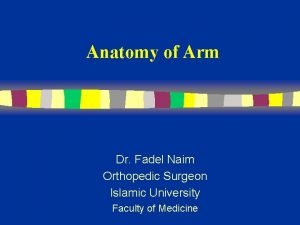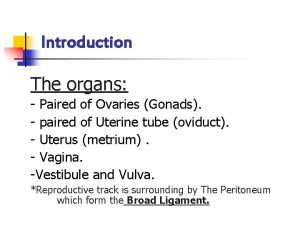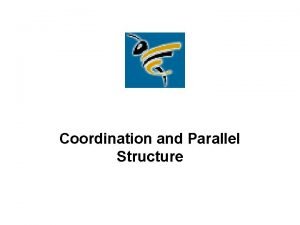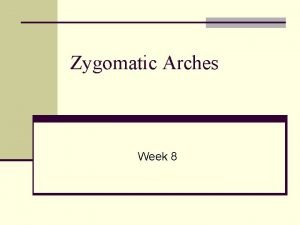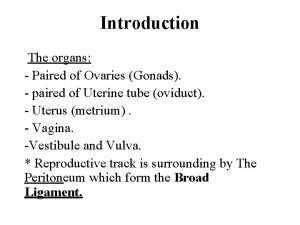Evolution of Aortic Arches Aortic arches are paired
















- Slides: 16

Evolution of Aortic Arches Aortic arches are paired blood vessels that emerge from the ventricle of the heart which are basically similar in number and disposition in different vertebrates during the embryonic stages. EMBRYONIC AORTIC ARCHES: During the embryonic stages • • • Six pairs of aortic arches develop in most gnathostomes and are named according to the name of bthe visceral clefts. These are designated by roman numerals. The first aortic arch named Mandicular , proceeds upwards on either side of the pharynx. Mandibular Aortic arch turn backwards as lateral aortae which both join mesially to form the common dorsal aorta. The second aortic arch becomes hyoid arch. The third, fourth, fifth & sixth are called branchial arches.


Modification of Aortic arches in different vertebrates : • The number of Aortic arches is different in different adult vertebrates but they built on the same fundamental plan in embryonic life. • The differences in number of aortic arches are due to the complexity of heart circulation in the mode of living from aquatic to terrestrial respiration. • There is a progressive reduction of aortic arches in the vertebrate series during evolution.

1. Aortic arches in primitive vertebrates : Branchiostoma (Amphioxus) has about 60 pairs of aortic arches , but Petromyzon has only 8 pairs and Myxine has 6 pairs of arches.

2. Aortic arches in fishes: In Elasmobranches: • The primitive elasmobranches, Heptanchus has only 7 pairs of aortic arches, where as Selachins has only 6 pairs of aortic arches. • In most sharks, Scoliodon, have 5 pairs of functional aortic arches; the first pair is reduced or disappears or replaced by the non-functional gills.

In Teleosts: • In most Teleosts or bony fishes, the first & second aortic arches are tend to disappear and thus only third , fourth, fifth and sixth pairs of aortic arches remain functional.

In Polypterus & Lungs fishes : • Due to the mode of living and respiration from aquatic to terrestrial, the first aortic arch disappeared and thus there are third fourth and sixth aortic arches which are functional. • A set of pulmonary artery arises from the sixth aortic arch near the dorsal aorta. NOTES: • In Elasmobranches and dipnonans, each aortic arch has one afferent artery and two efferent arteries in each gill. • In teleosts, each arch has one afferent and one efferent artery in each gill.

3. Aortic arches in Amphibians: Due to presence of lungs as the main respiratory organ, the importance of gills is diminished. In Urodels: • Four pairs of aortic arches [third to sixth] are functional in general. • The fifth pair is absent in Siren, Amphiuma. • The third pair forms the carotid artery and the fourth pair forms the systemic arches. • The radix or lateral aorta between third and fourth arches may persist as a vascular connection called ductus caroticus. • The sixth pair forms the pulmonary arteries which supply blood to skin and lungs.

• It retains connection with radix aorta, called ductus arteriosus.

In Anurans : • At metamorphosis, with loss of gills, first, second and fifth aortic arches disappear all together. • Thus three pairs of aortic arches [third, fourth and sixth] are fuctional in general. • Carotid arch takes oxygenated blood to head region. • Systemic arch on each side continues to dorsal aorta to distribute blood elsewhere except head and lung. • Pulmonary arch supplies venous blood exclusively to lungs for purification. • The ductus caroticus and ductus arteriosus are usually absent.


4. Aortic arches in reptiles: Reptiles are fully terrestrial vertebrates in which gills disappear all together and replaced by lungs. • Only three fuctional arches third, fourth ad sixth. • Right systemic arch[fourth] arises from left ventricle carrying oxygenated blood to the carotid arch[third] to be sent into head. • Left systemic arch [fourth] from right ventricle carrying deoxygenated or mixed blood to the body through dorsal aorta. • Pulmonary arch [sixth] arises from right ventricle carrying deoxygenated blood to lungs for purification. • Generally ductus caroticus and ductus arteriosus are absent but in certain snakes and lizards [uromastix] the ductus caroticus is present and in some turtle and sphenodon the ductus arteriosus is present.


5. Aortic arches in birds &mammals • Six arches develop in embryo, but only three arches [third, fourth and sixth] persist in the adult. • Single systemic aorta, right in birds and left in mammals carrying oxygenated blood. • Systemic aorta unites with the radix aorta to form dorsal aorta.

• Subclavian artery present on the left side in birds and on right side in mammals. • Third arch represents carotid arteries, which arise from systemic aorta. • Sixth arch arises from a single pulmonary trunk. • Embryonic ductus caroticus and ductus arteriosus also disappear.

BY KAVITA DHIMAN ASSISTANT PROFESSOR DEPTT. OF ZOOLOGY
 Mikael ferm
Mikael ferm Paired stimulus preference assessment data sheet
Paired stimulus preference assessment data sheet 2 sample t-test formula
2 sample t-test formula Paired statement key
Paired statement key Affect sentence in english
Affect sentence in english Unpaired vs paired t test
Unpaired vs paired t test Chapter 25 paired samples and blocks
Chapter 25 paired samples and blocks Paired reading passages
Paired reading passages Joseph tiffin
Joseph tiffin Paired conjunctions examples
Paired conjunctions examples Deltoid cut
Deltoid cut Epic greek tale that's paired with the iliad
Epic greek tale that's paired with the iliad Ovary sympathetic innervation
Ovary sympathetic innervation Paired t-test ppt
Paired t-test ppt How to calculate sample size in research
How to calculate sample size in research كلمات conjunction
كلمات conjunction Parallel structure with paired conjunctions
Parallel structure with paired conjunctions










